Dedicated to the Art
and Artists
of Relief Printmaking
15685 SW 116th Avenue
PMB 202
King City, OR 97224-2695
Phone: 503-641-3555
FAX: 503-641-3591
Orders: 800-832-4264
www.imcclains.com
Go to McClain's On-line Catalog
Request a catalog
[ Cancel Subscription ] |
September 2006
Interview
This month we interviewed Brian Lane, a Seattle-based printmaker, photographer and curator. In 1997, as a student at the University of Washington, he became hooked on printmaking after printing an ambitious 4 X 6 foot woodblock. He is currently an affiliate member of Gallery 110 in Seattle and is also co-founder of Print Zero Studios along with Jeremy Cody.
McClain's
What is your definition of a print?
Brian Lane
I love the smell of ink and old presses. I'm something of a traditionalist. Ink up your plate, block, or matrix and use pressure to transfer ink to the paper or other surface, these are the basic principles of printing. I'm not a fan of the strictly digital pigment prints being held in the same regard as traditional prints. However, I would encourage other methods and mediums (including digital) to be incorporated into the process and final print.
McClain's
What is Print Zero Studios exactly?
Brian Lane
It began in 2003 as an idea and now Print Zero Studios exists as our personal studios in Seattle, Washington & Athens, Ohio where Jeremy Cody is in graduate school. a Our online presence is crucial for networking exchanges, shows, and promoting printmakers. I host art shows out of the Seattle studio.
|
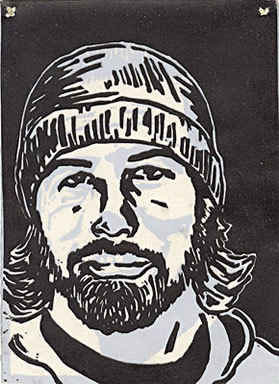
"Inherent" by Brian Lane, 7 x 5, Linocut, 2004. |
In the next few years, we'd like to have an open print studio established that would be available for artists and workshops.
McClain's
What is the mission of Print Zero Studios?
Brian Lane
To promote and strengthen the printmaking community through print exchanges and exhibitions. Importantly, we like to support and encourage ALL printmakers regardless of age or experience. McClain's
How did you first get the idea to host print exchanges? Brian Lane
We wanted to collect our friends' work before they moved away. Jeremy was involved in a print exchange through the art store he was working at, and I had a very good experience with a college print exchange a couple years earlier. |
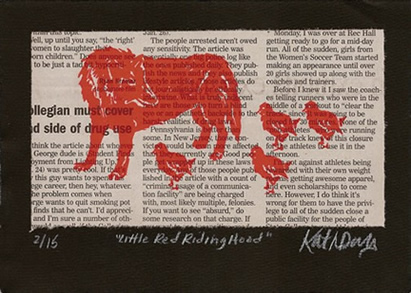
"Little Red Riding Hood" by Kathleen Donnelly, Silkscreen, 5 x 7, 2006. |
We collaborated on the idea and brought together 31 friends to participate. Our last one (#4 in 2006) had 285 participants from 18 countries. We have 600 prints in the collection now!
McClain's
Unlike many exchanges, the Print Zero Studios exchanges have no themes. Why not? Would you consider hosting a themed exchange in the future?
Brian Lane
We wanted to make it as easy as possible to participate. Working without a theme allows an artist to make work in his or her own comfort zone. We didn't want to intimidate, exclude, or limit anyone. Also, small dimensions were chosen for the same reasons. This has also helped to nurture the exchanges from small beginnings towards much larger international participation. And yes, it's likely that we'll do a themed exchange in the future.
McClain's
Do you have any advice for artists or amateur curators who'd like to host an exchange?
Brian Lane
It's actually very easy to do. Set the number for the edition size between 10 and 20. DO NOT CHANGE the edition size. Artists can be flakey, and they may drop out. The participants need to include $2 in postage and type out their contact info. Enjoy. Also,
online sites such as myspace.com & livejournal.com have active print communities that frequently host print exchanges. Just search for the printmaking groups.
|
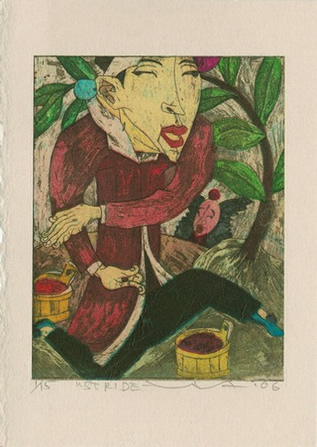
"Stride" by Yuji Hiratsuka, 7 x 5, Chine Colle and Etching, 2006. |
McClain's
Aside from taking time away, how has hosting the Print Zero Studios exchanges affected your own artwork?
Brian Lane
Honestly, the biggest gain for me has been on the networking and curating side of things. It feeds that part of my personality that wants to geek out to everyone about a great print or artist they should check out. Artistically, I hope to add a variety of techniques and materials to my arsenal based on what others have done.
McClain's
I'm especially curious about the international artists' perspectives. Did you notice any emerging global themes amongst all of the prints?
|
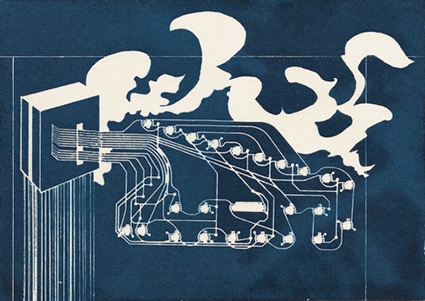
"c d e f g a b c d e" by Ross Anderson, Cyan-o-Type, 5 x 7, 2004. |
Brian Lane
The international themes or perspectives show very little difference from that of the American artists, at least for this most recent exchange. There are a few artists who specifically referenced their homeland or culture. One artist includes the name of her hometown in the Netherlands and Seattle in the image, as a way of connecting the two.
McClain's
What's next for Print Zero Studios? Are you going to host a new exchange?
Brian Lane
We don't have a date set for the next exchange. We've talked about doing a juried show next. Check McClain's Calendar and Links page for information on this and other exchanges. It's good to offer something else besides just print exchanges. We want to keep as many people associated with Print Zero and our shows as possible. A juried show would add variety and bring a new dimension to how we support the print community.
------------------------------------------------------------------
The Print Zero Studios 2006 Exchange #4 is currently showing at the University of Miami in Florida. All 285 prints can also be seen online at www.flickr.com/photos/printzerostudios/.
The three previous exchanges can be seen at www.PrintZeroStudios.com.
The five prints shown at right all were past submissions to Print Zero Studio print exchanges. |

"Memories of Karaoke 1 & 2 ", Jeffrey Brown, Relief Print, 7 x 5, 2004 |
_______________________________________________________________________________________________________________
TIPS________________________________________________________________________________________________________
Sharpening Tools
For many of us, keeping woodcut tools sharp can be a daunting task. The detailed instructions below will help take the mystery out of sharpening.
NOTE: These instructions were written with the use of ceramic and natural stones in mind. These stones require water NOT OIL as a lubricant. If you'll be using other type of stones, substitute oil for water where applicable. |
Flat tools: chisels and knives
Start with the back of the tool. It cannot be emphasized enough that any single bevel tool (knife or flat chisel) cannot be sharpened until the back (the flat, un-beveled side) is perfectly flat up to the cutting edge of the tool. The entire back of a large tool like a chisel doesn’t have to be flat, but from the cutting edge back about one half inch or so needs to be worked on the stones until this area is evenly smooth and shiny all the way across. To do this, lay about one half inch of the back of the tool perfectly flat on the long side of the stone, holding it with the handle perpendicular to the stone. Press the edge of the blade down with the fingers of your free hand. Rub the blade back and forth, being very careful to keep it completely flat against the stone at all times. (You may find it easier to stroke in one direction instead of moving the blade back and forth. Do what feels easiest to you.) Add water as needed to keep the stone wet so the tool moves easily. A magnifying glass is helpful to determine when the back has become flat. The metal will look the same all the way across the edge. If you finish with a 3000 or finer grit finishing stone, the back will look like a tiny mirror.
|
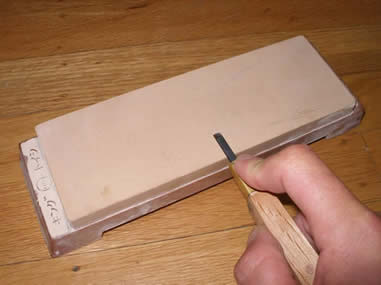
First, start by sharpening the backside of the chisel. This is the flat, un-beveled side. |
A mud or paste of grit will form as you sharpen which increases the cutting action. A nagura stone can be used to create this paste quickly. Just rub the nagura across your sharpening stone a few times. Repeat as necessary to keep a film of paste and water on the stone’s surface.
If you carefully feel the edge on the bevel side, you will notice a slight burr has formed from flattening the back. This will disappear when the beveled side is sharpened. So now turn the tool over and begin working on the bevel. To continue click here. |
_______________________________________________________________________________________________________________
SUBMISSIONS_______________________________________________________________________________________
McClain's Gallery
We are currently accepting new work for the 2007 Online and Catalog Galleries.
We have also yet to decide on a print for the 2007 catalog cover. If you are interested in submitting work, click here for detailed instructions.
Thank you in advance for your hard work.
We want to help you show it off!
|
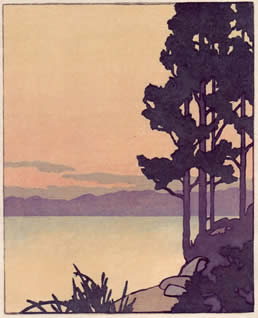
"Sunset" by Ray Heus, Moku Hanga Print, 2006. |
| NEWS_____________________________________________________________________________________________________ |
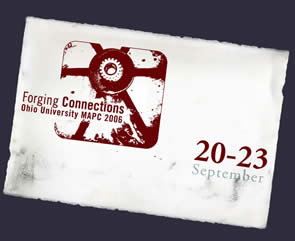
|
MAPC Conference 2006
McClain's will be attending the Mid-America Print Council Conference in Athens, Ohio. Look for us September 21-22 in the Baker Center Ballroom on campus. We hope to see you there!
Also, both Brian Lane and Jeremy Cody will be representing Print Zero Studios by showing a selection of prints during the Open Portfolio Session at the MAPC conference.
It will be a good chance to see first hand what they are up to.
|
___________________________________________________________________________________________________ |
|







